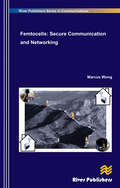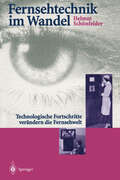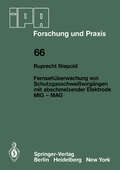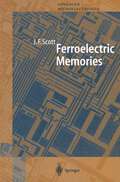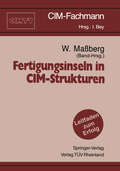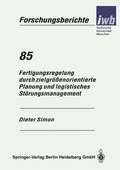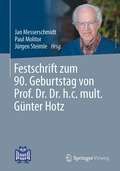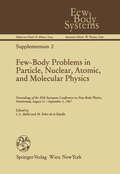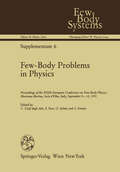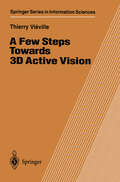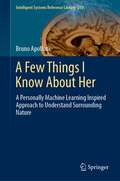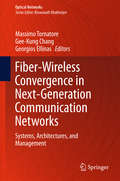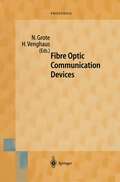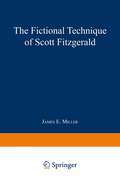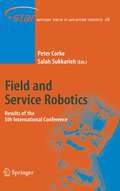- Table View
- List View
Femtocells: Secure Communication and Networking
by Marcus WongWith Femtocell popularities and deployments on the rise, a number of Femtocell security breach has been reported as a result of pre-standards versions of Femtocells that did not conform to published standards or implemented as a result of lack of understanding of basic security principles. A considerable amount of effort has been devoted, both in industry forums and standards developing organizations, towards creating technical specifications for the architecture, operational, and security of the Femtocells. Security remains on the minds of operators as the traditionally closed operator core network opens up with the Femtocells extending into the homes of users and potential hackers with more and more powerful tools. Technical topics discussed in the book include:• UMTS/LTE Femtocell security and threat analysis;• CDMA Femtocell security;• WiMAX Femtocell security;• LIPA and SIPTO security;• Small Cells;Femtocells: Secure Communication and Networking provides an in-depth analysis and research results on the security design of Femtocells based on UMTS, LTE, CDMA and WiMAX access technologies. Threat analysis, security requirements as well as security mechanisms used to counter the threats and potential attacks are provided in details covering every aspect of Femtocell security. Femtocells: Secure Communication and Networking is ideal for personnel in communication, networking and security industries as well as academic staff and master/research students in network security, computer science, operational research, electrical engineering and telecommunication systems and the Internet.
Femtocells: Secure Communication and Networking
by Marcus WongWith Femtocell popularities and deployments on the rise, a number of Femtocell security breach has been reported as a result of pre-standards versions of Femtocells that did not conform to published standards or implemented as a result of lack of understanding of basic security principles. A considerable amount of effort has been devoted, both in industry forums and standards developing organizations, towards creating technical specifications for the architecture, operational, and security of the Femtocells. Security remains on the minds of operators as the traditionally closed operator core network opens up with the Femtocells extending into the homes of users and potential hackers with more and more powerful tools. Technical topics discussed in the book include:• UMTS/LTE Femtocell security and threat analysis;• CDMA Femtocell security;• WiMAX Femtocell security;• LIPA and SIPTO security;• Small Cells;Femtocells: Secure Communication and Networking provides an in-depth analysis and research results on the security design of Femtocells based on UMTS, LTE, CDMA and WiMAX access technologies. Threat analysis, security requirements as well as security mechanisms used to counter the threats and potential attacks are provided in details covering every aspect of Femtocell security. Femtocells: Secure Communication and Networking is ideal for personnel in communication, networking and security industries as well as academic staff and master/research students in network security, computer science, operational research, electrical engineering and telecommunication systems and the Internet.
Fernfelddiagramm-Simulation ein- und zweidimensionaler Gruppenstrahler mit verkoppelten Elementen auf dem hybriden Analogrechner (Forschungsberichte des Landes Nordrhein-Westfalen #2323)
by Rudolf WohllebenFernsehtechnik im Wandel: Technologische Fortschritte verändern die Fernsehwelt (Edition Alcatel SEL Stiftung)
by Helmut SchönfelderBreitgefächerter Überblick von den mechanischen Anfängen des Fernsehens bis zur datenreduzierten digitalen Fernsehübertragung. Mit vielen farbigen Schirmbildaufnahmen veranschaulicht.
Fernsehüberwachung von Schutzgasschweißvorgängen mit abschmelzender Elektrode MIG — MAG (IPA-IAO - Forschung und Praxis #66)
by R. NiepoldFerroelectric Memories (Springer Series in Advanced Microelectronics #3)
by James F. ScottThis is the first comprehensive book on ferroelectric memories which contains chapters on device design, processing, testing, and device physics, as well as on breakdown, leakage currents, switching mechanisms, and fatigue. State-of-the-art device designs are included and illustrated among the books many figures. More than 500 up-to-date references and 76 problems make it useful as a research reference for physicists, engineers and students.
Fertigungsregelung durch zielgrößenorientierte Planung und logistisches Störungsmanagement (iwb Forschungsberichte #85)
by Dieter SimonFestschrift in Honor of R. Dennis Cook: Fifty Years of Contribution to Statistical Science
by Efstathia Bura Bing LiIn honor of professor and renowned statistician R. Dennis Cook, this festschrift explores his influential contributions to an array of statistical disciplines ranging from experimental design and population genetics, to statistical diagnostics and all areas of regression-related inference and analysis. Since the early 1990s, Prof. Cook has led the development of dimension reduction methodology in three distinct but related regression contexts: envelopes, sufficient dimension reduction (SDR), and regression graphics. In particular, he has made fundamental and pioneering contributions to SDR, inventing or co-inventing many popular dimension reduction methods, such as sliced average variance estimation, the minimum discrepancy approach, model-free variable selection, and sufficient dimension reduction subspaces.A prolific researcher and mentor, Prof. Cook is known for his ability to identify research problems in statistics that are both challenging and important, as well as his deep appreciation for the applied side of statistics. This collection of Prof. Cook's collaborators, colleagues, friends, and former students reflects the broad array of his contributions to the research and instructional arenas of statistics.
Festschrift zum 90. Geburtstag von Prof. Dr. Dr. h.c. mult. Günter Hotz
Die vorliegende Festschrift zum 90. Geburtstag von Prof. Dr. Dr. h.c. mult. Günter Hotz zeigt insbesondere über Kurzberichte der Doktorkinder die Nachwirkung von Günter Hotz’ Schaffen auf. Sie gibt damit auch einen schönen Überblick über die Informatik in Deutschland.
Fetal, Infant and Ophthalmic Medical Image Analysis: International Workshop, FIFI 2017, and 4th International Workshop, OMIA 2017, Held in Conjunction with MICCAI 2017, Québec City, QC, Canada, September 14, Proceedings (Lecture Notes in Computer Science #10554)
by M. Jorge Cardoso, Tal Arbel, Andrew Melbourne, Hrvoje Bogunovic, Pim Moeskops, Xinjian Chen, Ernst Schwartz, Mona Garvin, Emma Robinson, Emanuele Trucco, Michael Ebner, Yanwu Xu, Antonios Makropoulos, Adrien Desjardin and Tom VercauterenThis book constitutes the refereed joint proceedings of the International Workshop on Fetal and Infant Image Analysis, FIFI 2017, and the 6th International Workshop on Ophthalmic Medical Image Analysis, OMIA 2017, held in conjunction with the 20th International Conference on Medical Imaging and Computer-Assisted Intervention, MICCAI 2017, in Québec City, QC, Canada, in September 2017. The 8 full papers presented at FIFI 2017 and the 20 full papers presented at OMIA 2017 were carefully reviewed and selected. The FIFI papers feature research on advanced image analysis approaches focused on the analysis of growth and development in the fetal, infant and paediatric period. The OMIA papers cover various topics in the field of ophthalmic image analysis.
Fete of Combinatorics and Computer Science (Bolyai Society Mathematical Studies #20)
by Gyula O. H. Katona Alexander Schrijver Tamás SzönyiDiscrete Mathematics and theoretical computer science are closely linked research areas with strong impacts on applications and various other scientific disciplines. Both fields deeply cross fertilize each other. One of the persons who particularly contributed to building bridges between these and many other areas is László Lovász, whose outstanding scientific work has defined and shaped many research directions in the past 40 years. A number of friends and colleagues, all top authorities in their fields of expertise gathered at the two conferences in August 2008 in Hungary, celebrating Lovász' 60th birthday. It was a real fete of combinatorics and computer science. Some of these plenary speakers submitted their research or survey papers prior to the conferences. These are included in the volume "Building Bridges". The other speakers were able to finish their contribution only later, these are collected in the present volume.
Few-Body Problems in Particle, Nuclear, Atomic, and Molecular Physics: Proceedings of the XIth European Conference on Few-Body Physics, Fontevraud, August 31–September 5, 1987 (Few-Body Systems #2)
by Jean-Louis Ballot Michel Fabre De La RipelleThe 1987 Fontevraud Conference gathered more than 100 physicists for the purpose of discussing the latest developments of research on few-body problems. In addition to participants from most European countries representatives from Brazil, Canada, Israel, Japan, South Africa, and the USA took part in the meeting. In the conference program special emphasis was laid on bringing together the various fields, where few-body problems play an important role. Beyond the traditional areas of nuclear and particle physics, in recent years interest has been focussed especially on atomic and molecular physics. This developent is due to the design of new techniques for solving few-body problems under rather general premises. The proceedings contain all plenary talks and the contributions presented orally at the conference. They cover such topics as: few-quark systems and short-range phenomena, two- and three-body forces in quark as well as nucleonic systems, few-hadron bound states, response of few-body systems to electromagnetic and hadronic probes, form factors, hypernuclei, atomic and molecular few-body systems, hyperspherical method, separable expansions, numerical techniques, etc. It appears that recently, even in one year after the Tokyo-Sendai Conference, much progress has been achieved in research on various few-body systems. The present volume gives a comprehensive summary of the modern state of the art and at the same time a proper account of the most recent results obtained in the different institutions and laboratories.
Few-Body Problems in Physics: Proceedings of the XIIIth European Conference on Few-Body Physics, Marciana Marina, Isola d’Elba, Italy, September 9–14, 1991 (Few-Body Systems #6)
by Claudio Ciofi Degli Atti Emanuele Pace Giovanni Salme Silvano SimulaA Few Steps Towards 3D Active Vision (Springer Series in Information Sciences #33)
by Thierry VievilleT. Viéville: A Few Steps Towards 3D Active Vision appears as Vol. 33 in the Springer Series in Information Sciences. A specific problem in the field of active vision is analyzed, namely how suitable is it to explicitly use 3D visual cues in a reactive visual task? The author has collected a set of studies on this subject and has used these experimental and theoretical developments to propose a synthetic view on the problem, completed by some specific experiments. With this book scientists and graduate students will have a complete set of methods, algorithms, and experiments to introduce 3D visual cues in active visual perception mechanisms, e.g. autocalibration of visual sensors on robotic heads and mobile robots. Analogies with biological visual systems provide an easy introduction to this subject.
A Few Things I Know About Her: A Personally Machine Learning Inspired Approach to Understand Surrounding Nature (Intelligent Systems Reference Library #219)
by Bruno ApolloniThis book reconsiders key issues, such as description and explanation, which affect data analytics. For starters: the soul does not exist. Once released from this cumbersome roommate, we are left with complex biological systems: namely, ourselves, who must configure their environment in terms of worlds that are compatible with what they sense. Far from supplying yet another cosmogony, the book provides the cultivated reader with computational tools for describing and understanding data arising from his surroundings, such as climate parameters or stock market trends, even the win/defeat story of his son football team. Besides the superposition of the very many universes considered by quantum mechanics, we aim to manage families of worlds that may have generated those data through the key feature of their compatibility. Starting from a sharp engineering of ourselves in term of pairs consisting of genome plus a neuron ensemble, we toss this feature in different cognitive frameworks within a span of exploitations ranging from probability distributions to the latest implementations of machine learning. From the perspective of human society as an ensemble of the above pairs, the book also provides scientific tools for analyzing the benefits and drawbacks of the modern paradigm of the world as a service.
Fiber Optics: Technology and Applications (Applications of Communications Theory)
by Stewart D. PersonickThis book is an outgrowth of a course given by the author for people in industry, government, and universities wishing to understand the implica tions of emerging optical fiber technology, and how this technology can be applied to their specific information transport and sensing system needs. The course, in turn, is an outgrowth of 15 exciting years during which the author participated in the research and development, as well as in the application, of fiber technology. The aim of this book is to provide the reader with a working knowledge of the components and subsystems which make up fiber systems and of a wide variety of implemented and proposed applications for fiber technology. The book is directed primarily at those who would be users, as opposed to developers, of the technology. The first half of this book is an overview of components and subsys tems including fibers, connectors, cables, sources, detectors, receivers, transmitters, and miscellaneous components. The goal is to familiarize the reader with the properties of these components and subsystems to the extent necessary to understand their potential applications and limitations.
Fiber Optics Installer and Technician Guide
by Bill Woodward Emile B. HussonFor years, fiber optics was the future. Now, it's the present, and the time has come to act if you want to make a career in this fast-growing field. The Fiber Optics Installer and Technician Guide is a comprehensive resource designed to prepare you for the two leading fiber optics certifications, Fiber Optics Installer (FOI) and Fiber Optics Technician (FOT). This book's practical, objective-focused coverage includes: The history of fiber optics Principles of fiber optic transmission Optical fiber characteristics, construction, and theory Safety considerations Cables, connectors, and splicing Fiber optic light sources and transmitters Fiber optic detectors and receivers Passive components and multiplexers Fiber optic links Testing equipment Techniques for testing links and cables Troubleshooting and restoration techniques Note: CD-ROM/DVD and other supplementary materials are not included as part of eBook file.
Fiber Optics Installer (FOI) Certification Exam Guide
by Bill WoodwardPass the FOI exam with a strong foundation in fiber optic technology Fiber Optics Installer (FOI) Certification Exam Guide gives you a solid foundation in fiber optics and thorough preparation for the Fiber Optics Installer (FOI) certification. Endorsed by the Electronics Technicians Association, International, this guide serves as both a comprehensive self-study course and a useful desk reference for aspiring fiber optics installers. Coverage includes the basic principles of light, optical fiber construction, safety, fusion, mechanical splicing, connectors, fiber-optic light sources, transmitters, detectors, test equipment, and more. Each chapter meets or exceeds the ETA FOI knowledge competency, with key exam information highlighted for easy reference. Real-world scenarios illustrate how particular solutions are applied in common working environments, giving you a clear understanding of to use the tactics in the field. Chapter exercises and review questions offer plenty of opportunity for practice. This book helps you prepare for certification, and more importantly, the everyday work the job entails. Determine how much you already know with a pre-study assessment Find key exam information and terms quickly with chapter-by-chapter objectives Study real-world scenarios to understand how concepts are applied Pinpoint weak areas with practice and review questions that test your knowledge If you are seeking a strong knowledge base — and complete exam prep — you will find Fiber Optics Installer (FOI) Certification Exam Guide to be a critically useful reference.
Fiber Optics Installer (FOI) Certification Exam Guide
by Bill WoodwardPass the FOI exam with a strong foundation in fiber optic technology Fiber Optics Installer (FOI) Certification Exam Guide gives you a solid foundation in fiber optics and thorough preparation for the Fiber Optics Installer (FOI) certification. Endorsed by the Electronics Technicians Association, International, this guide serves as both a comprehensive self-study course and a useful desk reference for aspiring fiber optics installers. Coverage includes the basic principles of light, optical fiber construction, safety, fusion, mechanical splicing, connectors, fiber-optic light sources, transmitters, detectors, test equipment, and more. Each chapter meets or exceeds the ETA FOI knowledge competency, with key exam information highlighted for easy reference. Real-world scenarios illustrate how particular solutions are applied in common working environments, giving you a clear understanding of to use the tactics in the field. Chapter exercises and review questions offer plenty of opportunity for practice. This book helps you prepare for certification, and more importantly, the everyday work the job entails. Determine how much you already know with a pre-study assessment Find key exam information and terms quickly with chapter-by-chapter objectives Study real-world scenarios to understand how concepts are applied Pinpoint weak areas with practice and review questions that test your knowledge If you are seeking a strong knowledge base — and complete exam prep — you will find Fiber Optics Installer (FOI) Certification Exam Guide to be a critically useful reference.
Fiber-Wireless Convergence in Next-Generation Communication Networks: Systems, Architectures, and Management (Optical Networks)
by Massimo Tornatore Gee-Kung Chang Georgios EllinasThis book investigates new enabling technologies for Fi-Wi convergence. The editors discuss Fi-Wi technologies at the three major network levels involved in the path towards convergence: system level, network architecture level, and network management level. The main topics will be: a. At system level: Radio over Fiber (digitalized vs. analogic, standardization, E-band and beyond) and 5G wireless technologies; b. Network architecture level: NGPON, WDM-PON, BBU Hotelling, Cloud Radio Access Networks (C-RANs), HetNets. c. Network management level: SDN for convergence, Next-generation Point-of-Presence, Wi-Fi LTE Handover, Cooperative MultiPoint.
Fibre Optic Communication Devices (Springer Series in Photonics #4)
by Norbert Grote Herbert VenghausOptoelectronic devices and fibre optics are the basis of cutting-edge communication systems. This monograph deals with the various components of these systems, including lasers, amplifiers, modulators, converters, filters, sensors, and more.
Field and Service Robotics: Results of the 5th International Conference (Springer Tracts in Advanced Robotics #25)
by Peter Corke Salah SukkariehThe 5th International Conference on Field and Service Robotics (FSR05) was held in Port Douglas, Australia, on 29th - 31st July 2005, and brought together the worlds' leading experts in field and service automation. The goal of the conference was to report and encourage the latest research and practical results towards the use of field and service robotics in the community with particular focus on proven technology. The conference provided a forum for researchers, professionals and robot manufacturers to exchange up-to-date technical knowledge and experience. Field robots are robots which operate in outdoor, complex, and dynamic environments. Service robots are those that work closely with humans, with particular applications involving indoor and structured environments. There are a wide range of topics presented in this issue on field and service robots including: Agricultural and Forestry Robotics, Mining and Exploration Robots, Robots for Construction, Security & Defence Robots, Cleaning Robots, Autonomous Underwater Vehicles and Autonomous Flying Robots. This meeting was the fifth in the series and brings FSR back to Australia where it was first held. FSR has been held every 2 years, starting with Canberra 1997, followed by Pittsburgh 1999, Helsinki 2001 and Lake Yamanaka 2003.
